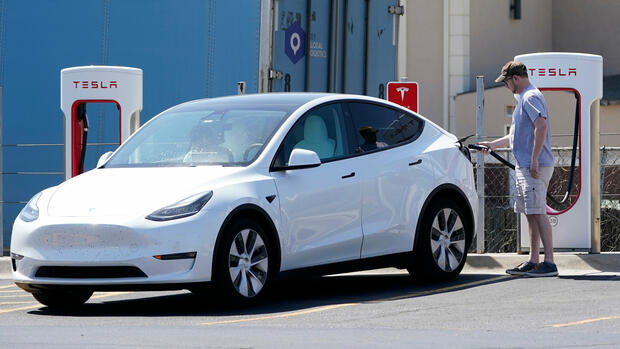A missing information sign costs Volkwagen 1.1 million euros. The penalty was imposed by the Lower Saxony data protection authority, because the automaker had been caught in 2019 with a test vehicle that filmed the traffic. With the image data, the driving assistance system is to be improved and accidents are to be prevented. However, the car did not have the necessary magnetic signs with a camera symbol.
In the future, however, it will not be done with a hint symbol. Cars are increasingly becoming rolling steady cams, with cameras invisible to outsiders. These are indispensable for the assistance systems in order to train and improve them with huge amounts of video data. To do this, they must be stored and transferred: a red cloth for consumer advocates who suspect violations of the European Data protection Regulation DSGVO. “We are taking a close look at what car manufacturers are doing,” says Heiko Dünkel, who heads the law enforcement team at the Federation of German Consumer Organizations (Verbraucherzentrale Bundesverband).
A few weeks ago, the association filed a lawsuit with the Berlin District Court against Tesla. The “guard mode” of the electric cars permanently monitors the environment when parking and stores the data in certain cases. Although other manufacturers do not offer such a function as the “Sentry Mode”, but their camera functions must also be tested while driving. “Tesla is just the beginning,” Dünkel tells Handelsblatt.
The lawsuit, according to experts, will be held in court only in 2023. One way or another, she will lose Tesla, according to Thilo Weichert, former data protection Officer of Schleswig-Holstein and member of the Data protection Expertise network. However, this will have fewer consequences for the automaker than for the owners of Tesla vehicles. When buying, you take the risk. The Terms of Use state that it is “your sole responsibility” to ensure that “applicable laws and regulations” are observed. “This is a popular way for IT companies,” says Weichert, “to shift responsibility.“
Tesla completely trusts the cameras
With all sensors, a car can produce four to six terabytes of data per day. For the amount of data of one terabyte, you need 1500 CDs to store the information. Most of the information is problem-free from a data protection point of view. The vehicle does not store the data. But those that are transmitted and stored are problematic for data protectors. Is it necessary to raise them? And will they be anonymized? “The need for consulting is increasing enormously,” says Alexander Duisberg, who, as a partner and technology expert at the law firm Bird & Bird, advises numerous car companies.
The fact that Tesla is being charged is not surprising. The US company is not only a pioneer in electric cars, but also pursues a unique approach to autonomous driving assistance systems. Tesla renounces radar and lidar, wants to reach level 4 or 5 exclusively with camera data. This is the unit of measurement for driving assistance systems, with one as the lowest and five as the highest degree of autonomous driving.
Currently, vehicles from Mercedes and Co. can drive up to 60 kilometers per hour in Germany at level 3, Tesla is coming to level 2. In order to achieve higher driving safety, Elon Musk’s company must prepare artificial intelligence (AI) for all conceivable “edge cases”: borderline cases in traffic, such as wrong-driving cyclists or construction sites that are changing.
The problem is the “edge cases”
Today’s assistance systems already recognize almost all situations correctly. But with fully automated driving, much higher success rates are necessary, no mistake should happen. For this, assistance systems must also master “edge cases”. For this purpose, Tesla has been collecting video data from its customers in the USA for many years in order to train the AI on it. Hundreds of employees evaluate the images and label them so that the neural network understands them.
This calls data protectors like Weichert from Netzwerk Datenschutzexpertise onto the scene. Almost two years ago, he pointed out possible violations of the GDPR by Tesla in a report. The former data protection officer criticizes above all the “guardian mode”: there is a lack of the necessity of data collection, you can not just film everyone who passes by a Tesla. The manufacturer has not responded since then, as Weichert tells the Handelsblatt.
The transmission of the data to the USA is also still a problem, the data protection regulations there are not in accordance with the GDPR. “Even if Tesla stores the data on a server in Germany or Europe, that’s not enough,” says Weichert. Because the US would have access to the data “without legal control” due to laws such as the “Patriot Act”.
Anonymization of the data is time-consuming
One way out for the car companies: anonymize the data. However, there is a risk that important information for the companies will be lost. For example, where is the pedestrian looking? This can be decisive for the interpretation of traffic, as the direction of view often allows conclusions to be drawn about the intention, says Steffen Heinrich, head of the video specialist Peregrine.
Heinrich used to work at VW and other car brands, founded Peregrine in Berlin in 2018. The start-up works for car suppliers and other customers. With its technology, it pixelates the data before saving it. “License plates are easy to recognize and change,” says founder Heinrich. “It gets more difficult with faces, for example, of cyclists who are moving, or with larger crowds – but this is also solvable.“
Another option is to alienate images or videos with synthetic data. Thus, an artificially created face can be put on the pedestrian, with the correct direction of view. In this way, no important information is lost, the neural networks can also be trained later with this data. But the alienation has disadvantages: “This is more complex, needs more energy and computing capacity,” says Heinrich.
The best data protection is to collect as little data as possible. This is the approach of the Israeli start-up Autobrains, which is developing an AI for Continental or other customers that should get by with less data. The AI assigns so-called simple “signatures” to all objects: lines, colors or other structures in the image, without going into the last detail. “Recognition rates of 95 percent are not the challenge,” says Nils Berkemeyer, VP Corporate Development of Autobrains. “In our business, it’s all about the last five percent, the unpredictable borderline cases that you can’t train manually. We are particularly strong here.“









